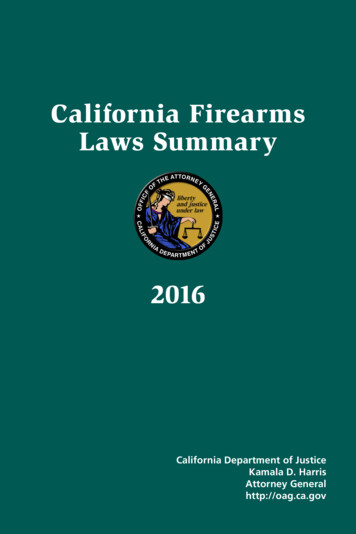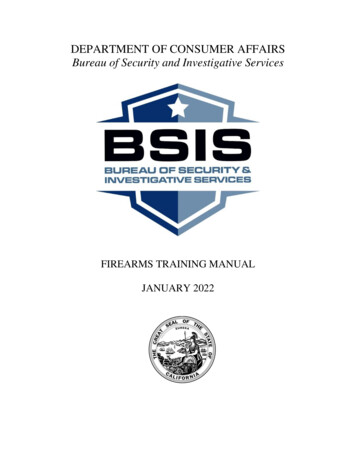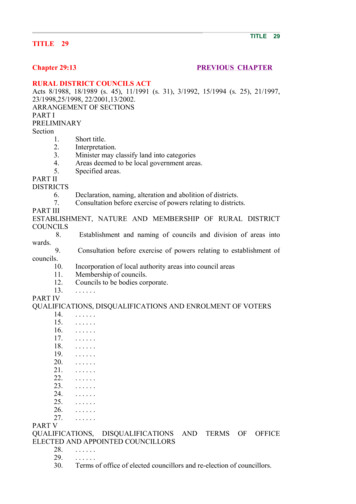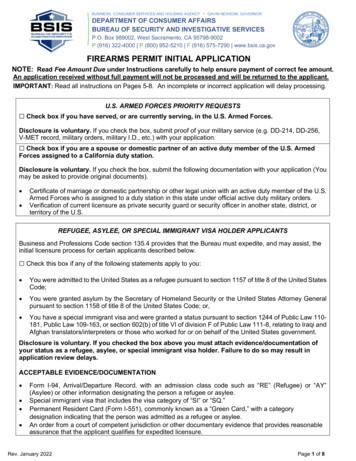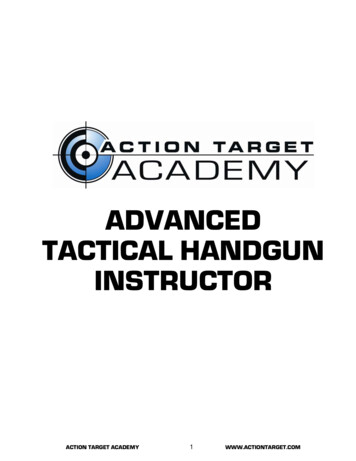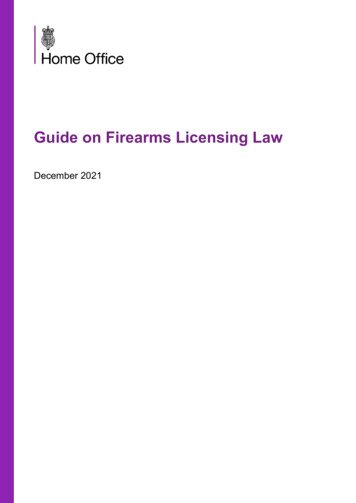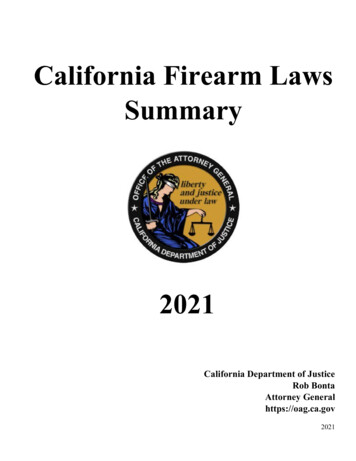
Transcription
California Firearm LawsSummary2021California Department of JusticeRob BontaAttorney Generalhttps://oag.ca.gov2021
Table of ContentsCalifornia Firearm Laws SummaryINTRODUCTION .1PERSONS INELIGIBLE TO POSSESS FIREARMS .1REAL ID REQUIREMENTS FOR ELIGIBILITY CHECKS .3SALES AND TRANSFERS OF FIREARMS.4SALES AND TRANSFERS OF AMMUNITION .7PROHIBITED FIREARM TRANSFERS AND STRAW PURCHASES .8REPORTING REQUIREMENTS FOR NEW CALIFORNIA RESIDENTS .8SHIPMENT OF FIREARMS .8CARRYING FIREARMS ABOARD COMMON CARRIERS.9FIREARMS IN THE HOME, BUSINESS OR AT THE CAMPSITE .9TRANSPORTATION OF FIREARMS .9USE OF LETHAL FORCE IN SELF-DEFENSE.10CARRYING A CONCEALED WEAPON WITHOUT A LICENSE .12LOADED FIREARMS IN PUBLIC .12OPENLY CARRYING AN UNLOADED HANDGUN .13PUNISHMENT FOR CARRYING UNRECORDED HANDGUN .13UNIQUE SERIAL NUMBER APPLICATION PROCESS .14MISCELLANEOUS PROHIBITED ACTS .14NEW FIREARM/WEAPON LAWS .172021
California Firearm Laws SummaryINTRODUCTIONAs the owner of a firearm, it is your responsibility to understand and comply with all federal, stateand local laws regarding firearms ownership. Many of the laws described below pertain to thepossession, use, and storage of firearms in the home and merit careful review. This CaliforniaFirearm Laws Summary provides general information of California laws that govern commonpossession and use of firearms by persons other than law enforcement officers or members of thearmed forces. It is not designed to provide individual guidance for specific situations. The legality ofany specific act of possession or use will ultimately be determined by applicable federal and statestatutory and case law. Persons having specific questions are encouraged to seek legal advice from anattorney, or consult their local law enforcement agency, local prosecutor, or law library. TheCalifornia Department of Justice (DOJ) and all other public entities are immune from any liabilityarising from the drafting, publication, dissemination, or reliance upon this information. This versionof the California Firearm Laws Summary covers laws that were enacted from 2106 through 2021.This document has been prepared in accordance with Penal Code section 34205, which requires theDOJ to prepare and make available this summary.PERSONS INELIGIBLE TO POSSESS FIREARMSThe following persons are prohibited from possessing firearms (Pen. Code, §§ 29800-29825, 29900;Welf. & Inst. Code, §§ 8100, 8103). Note that the information below does not include firearmprohibitions under federal law (18 U.S.C. § 922(g)(1)-(9)):Lifetime Prohibitions Any person who has been convicted of a felony or any violent offense including murder,mayhem, rape, attempted murder, arson, robbery, kidnapping, or any other violent felonyenumerated in Penal Code section 29905.Any person convicted of an offense including a misdemeanor violation involving assaultupon a person with a firearm, or machinegun, or an outstanding warrant for a misdemeanoroffense or any other offense enumerated in Penal Code sections 23515, 29800, and 29805.Any person convicted of inflicting corporal injury on a spouse or significant other (Pen. Code§ 273.5)after January 1, 2019 who subsequently owns, purchases, receives or has inpossession or under custody or control any firearm.(Penal Code section 29805)Any person with two or more convictions for drawing or exhibiting any firearm, loaded orunloaded, in a rude, angry, or threatening manner, or unlawfully using a firearm in any fightor quarrel in the presence of another person except in self-defense violating Penal Codesection 417, subdivision (a)(2).Any person adjudicated to be a danger to others as a result of a mental disorder, or a mentallydisordered sex offender. (Welf. & Inst. Code, § 8103, subd. (a)(1).)1
Any person found by a court to be mentally incompetent to stand trial or not guilty by reasonof insanity of any crime, unless the court has made a finding of restoration of competence orsanity. (Welf. & Inst. Code, § 8103, subds. (b)(1), (c)(1), and (d)(1).)10-Year Prohibitions Any person convicted of, or has an outstanding warrant for, a misdemeanor violation of thefollowing: Penal Code sections 71, 76, 136.1, 136.5, 140, 148 subdivision (d), 148.5subdivision (f), 171b, 171c subdivision (a) paragraph (1), 171d, 186.28, 240, 241, 242, 243,243.4, 244.5, 245, 245.5, 246.3, 247, 273.5, 273.6, 417, 417.6, 422, 422.6, 626.9, 646.9,830.95, 17500, 17510 , 25300, 25800, 26100 subdivision (b) or (d), 27510, 27590subdivision (c), 30315, or 32625; and Welfare and Institutions Code sections 871.5, 1001.5,8100, 8101, or 8103.5-Year Prohibitions Any person taken into custody as a danger to self or others, assessed, and admitted to amental health facility under Welfare and Institutions Code sections 5150, 5151, 5152; orcertified under Welfare and Institutions Code sections 5250, 5260, 5270.15. Persons certifiedunder Welfare and Institutions Code sections 5250, 5260, or 5270.15 may be subject to alifetime prohibition pursuant to federal law. (Welf. & Inst. Code, §§ 8100 and 8103.)Any person who communicates a threat (against any reasonably identifiable victim) to alicensed psychotherapist which is subsequently reported to law enforcement. (Welf. & Inst.Code, § 8100, subd. (b).)Any person who owns/possesses a firearm or ammunition with knowledge that they areprohibited from doing so by a gun violence restraining order, is guilty of a misdemeanor.(Pen. Code, § 18205.)Juvenile Prohibitions Juveniles adjudged wards of the juvenile court are prohibited until they reach age 30 if theycommitted an offense listed in Welfare and Institutions Code section 707, subdivision (b).(Pen. Code, § 29820.)Miscellaneous Prohibitions Any person denied firearm possession as a condition of probation pursuant to Penal Codesection 29900, subdivision (c).Any person while he or she is either a voluntary patient in a mental health facility or under agravely disabled conservatorship (due to a mental disorder or impairment by chronicalcoholism) and if he or she is found to be a danger to self or others. (Welf. & Inst. Code, §8103, subd. (e).)Any person addicted to the use of narcotics. (Pen. Code, § 29800, subd. (a).)2
Any person who is subject to a protective order as defined in Family Code section 6218,Penal Code sections 136.2 or 646.91, Welfare and Institutions Code section 15657.03 or atemporary restraining order issued pursuant to Code of Civil Procedure sections 527.6, 527.8,or 527.85. (Pen. Code, § 29825.)For any person who is the subject of an outstanding warrant (felony or specifiedmisdemeanor), only if the person has knowledge of the warrant, then they are prohibitedfrom owning or possessing a firearm. (Pen. Code, §§ 29800 and 29805.)Personal Firearms Eligibility CheckAny person may obtain from the DOJ a determination as to whether he or she is eligible topossess firearms (review of California records only). The Personal Firearms Eligibility Checkapplication form (BOF 116) and instructions are on the DOJ website athttps://oag.ca.gov/firearms/forms. The cost for this eligibility check is 20. (Pen. Code, §30105.)REAL ID REQUIREMENTS FOR ELIGIBILITY CHECKSAs of July 1, 2019, additional documentation is required for eligibility checks for which the applicantpossesses a federal non-compliant California driver license or identification card, also known as aREAL ID. For the purpose of this section, “eligibility checks” refers to background checks based onany application or report for which an applicant is required to submit a driver license or identificationcard, or the number from a driver license or identification card, so that the DOJ may determine theapplicant’s eligibility to possess a firearm or ammunition under state or federal law.For all eligibility checks, a copy of the applicant’s California driver license or identification card, orout-of-state driver license, if applicable, shall be submitted, as specified in the California Code ofRegulations, title 11, section 4045.1.If the applicant presents a federal non-compliant California driver license or identification card withthe notation “FEDERAL LIMITS APPLY” on the front, the applicant shall also submit proof oflawful presence in the United States in the form of one of the following documents:(1) Valid, unexpired U.S. passport or passport card.(2) Certified copy of U.S. birth certificate.(3) Certification of Birth Abroad (FS-545), Certification of Report of Birth (DS-1350) orConsular Report of Birth Abroad of a Citizen of the United States of America (FS240), issued bythe U.S. Department of State.(4) Valid, unexpired foreign passport with valid U.S. immigrant visa and approved Record ofArrival/Departure (I-94) form.(5) Certified copy of birth certificate from a U.S. Territory.(6) Certificate of Naturalization or U.S. Citizenship.(7) Valid, unexpired Permanent Resident Card.3
If the applicant’s name as it appears on the federal non-compliant California driver license oridentification card differs from the name on the proof of lawful presence document, the applicantshall also submit one of the following certified documents:(1) An adoption document that contains the legal name of the applicant as a result of theadoption.(2) A name change document that contains the applicant’s legal name both before and, as a resultof, the name change.(3) A marriage certificate.(4) A dissolution of marriage document that contains the legal name of the applicant as a resultof the court action.(5) A certificate, declaration or registration document verifying the formation of a domesticpartnership.(6) A dissolution of domestic partnership document that contains the legal name of the applicantas a result of the court action.(Cal. Code Regs. § 4045.1.)SALES AND TRANSFERS OF FIREARMSIn California, only licensed California firearm dealers who possess a valid Certificate of Eligibility(COE) are authorized to engage in retail sales of firearms. These retail sales require the purchaser toprovide personal identifier information for the Dealer Record of Sale (DROS) document that thefirearm dealer must submit to the DOJ. There is a mandatory 10-day waiting period before thefirearms dealer can deliver the firearm to the purchaser. During this 10-day waiting period, the DOJconducts a firearm eligibility background check to ensure the purchaser is not prohibited fromlawfully possessing firearms. Although there are exceptions, generally all firearm purchasers must beat least 21 years of age to purchase any firearm. As of January 1, 2020, you must be at least 21 yearsof age to purchase a semiautomatic centerfire rifle (unless you have a law enforcement or militaryexemption). Additionally, purchasers must be California residents with a valid driver license oridentification card issued by the California Department of Motor Vehicles.It is illegal for any person who is not a California licensed firearm dealer to sell or transfer a firearmto another non-licensed person (a private party) unless the sale or transfer is completed through alicensed California firearm dealer. A “Private Party Transfer” (PPT) can be conducted at any licensedCalifornia firearm dealer. The buyer and seller must complete the required DROS document in personat the licensed firearms dealer and deliver the firearm to the dealer who will retain possession of thefirearm during the mandatory 10-day waiting period. In addition to the applicable state fees, thefirearm dealer may charge a fee not to exceed 10 per firearm for conducting the PPT. (Pen. Code §28050.)The infrequent transfer of firearms between immediate family members is exempt from the lawrequiring PPTs to be conducted through a licensed firearm dealer. For purposes of this exemption,“immediate family member” means parent and child, and grandparent and grandchild but does notinclude brothers or sisters. (Pen. Code, § 16720.) Prior to taking possession of the firearm the4
transferee must also comply with the Firearm Safety Certificate requirement described below. Within30 days of the transfer, the transferee must also submit a report of the transaction to the DOJ bydownloading the form, “Report of Operation of Law or Intra-Familial Firearm Transaction,” (BOF4544A [Rev. 01/2020]) from the DOJ website at https://oag.ca.gov/firearms/forms or completing andsubmitting the form electronically via the internet at https://cfars.doj.ca.gov.The reclaiming of a pawned firearm is subject to the DROS and 10-day waiting period requirements.Specific statutory requirements relating to sales and transfers of firearms are as follows:Proof of Residency RequirementTo purchase a handgun in California, you must present documentation indicating that you are aCalifornia resident. Acceptable documentation includes a utility bill from within the last threemonths, a residential lease, a property deed, or military permanent duty station orders indicatingassignment within California.The address provided on the proof-of-residency document must match either the address on theDROS or the address on the purchaser’s California driver license or identification card. (Pen.Code, § 26845.)Firearm Safety Certificate RequirementTo purchase or acquire a firearm, you must have a valid Firearm Safety Certificate (FSC). Toobtain an FSC, you must score at least 75% on an objective written test pertaining to firearmlaws and safety requirements. The test is administered by DOJ Certified Instructors, who areoften located at firearm dealers. An FSC is valid for five years. You may be charged up to 25for an FSC. Firearms being returned to their owners, such as pawn returns, are exempt from thisrequirement. In the event of a lost, stolen or destroyed FSC, the issuing DOJ Certified Instructorwill issue a replacement FSC for a fee of 5. You must present proof of identity to receive areplacement FSC. (Pen. Code, §§ 31610-31670.) (Cal. Code. Regs. § 4255.)Safe Handling Demonstration RequirementPrior to taking possession of a firearm, you must successfully perform a safe handlingdemonstration with the firearm being purchased or acquired. Safe handling demonstrations mustbe performed in the presence of a DOJ Certified Instructor sometime between the date the DROSis submitted to the DOJ and the delivery of the firearm, and are generally performed at thefirearm dealer. The purchaser and firearm dealer must sign an affidavit stating the safe handlingdemonstration was completed. The steps required to complete the safe handling demonstrationcan be found starting on page 12 of the Firearm Safety Certificate Study Guide, June 2020,located at https://oag.ca.gov/firearms/forms/. Pawn returns and intra-familial transfers are notsubject to the safe handling demonstration requirement. (Pen. Code, § 26850.)5
Firearm Safety Device RequirementAll firearms (long guns and handguns) purchased in California must be accompanied by afirearm safety device (FSD) that has passed required safety and functionality tests and is listedon the DOJ’s official roster of approved firearm safety devices. The current roster of certifiedFSDs is available on the DOJ website at https://oag.ca.gov/firearms/fsdcertlist. The FSDrequirement can also be satisfied if the purchaser signs an affidavit declaring ownership of eithera DOJ-approved lock box or a gun safe capable of accommodating the firearm being purchased,and presents an original receipt for purchase of the gun safe, or other proof of purchase orownership of the gun safe. Pawn returns and intra-familial transfers are not subject to the FSDrequirement. (Pen. Code, §§ 23635-23690.)Roster of Handguns Certified for Sale in CaliforniaNo handgun may be sold by a firearm dealer to the public unless it is of a make and model thathas passed required safety and functionality tests and is listed on the DOJ’s official Roster ofHandguns Certified for Sale in California. The current Roster of Handguns Certified for Sale inCalifornia is on the DOJ website at https://oag.ca.gov/firearms/certguns. PPTs, intra-familialtransfers, curio/relic handguns, certain single-action revolvers, and pawn/consignment returns areexempt from this requirement. (Pen. Code, § 32000 et. seq.)One-Gun-per-30-Days LimitNo person shall make an application to purchase more than one handgun or, one semiautomaticcenterfire rifle within any 30-day period. Exemptions to the one-handgun-per-30-days limitinclude pawn returns, intra-familial transfers, and private party transfers. (Pen. Code, §§ 27535and 27540.)Handgun Sales and Transfer RequirementsRetailSalesPrivate PartyTransfersIntrafamilialTransfersPawnsProof of Residency RequirementYesYesNoYesFirearm Safety Certificate RequirementYesYesYesNoSafe Handling Demonstration RequirementYesYesNoNoFirearm Safety Device RequirementYesYesNoNoRoster of Handguns Certified for Sale inCaliforniaYesNoNoNoOne-Handgun-Per-30-Days LimitYesNoNoNo6
Long Gun Sales and Transfer RequirementsRetailSalesPrivate Residency RequirementNoNoNoNoFirearm Safety Certificate RequirementYesYesYesNoSafe Handling Demonstration RequirementYesYesNoNoFirearm Safety Device RequirementYesYesNoNoSALES AND TRANSFERS OF AMMUNITIONPersons seeking to purchase or transfer ammunition must undergo an eligibility check, and beapproved by the DOJ prior to the sale or transfer of ammunition, except as otherwise specified. DOJapproval shall occur electronically through a licensed ammunition vendor. Pursuant to Penal Codesections 30352 and 30370, the DOJ will determine that a person is eligible to purchase or transferammunition if they meet one of the following requirements:(1) The person has a current Certificate of Eligibility issued by the DOJ.(2) The person’s information matches an entry in the Automated Firearms System (name,date of birth, current address, and driver license or other government identification) and doesnot fall within a class of persons who are prohibited from owning or possessing ammunition.The DOJ shall make this determination by cross-referencing the Prohibited Armed Personsfile (also known as the Armed and Prohibited Persons System).(3) The person is not prohibited from purchasing or possessing ammunition. The DOJdetermines eligibility based on a comprehensive review of its records (similar to a firearmeligibility check). (Please note: this eligibility check requires a manual review of records by aDOJ analyst. As such, the DOJ may take longer to respond with a determination ofeligibility. Response times may take several days.)(4) The person was approved by the DOJ to receive a firearm from the ammunition vendor,pursuant to Penal Code section 28220, if that vendor is a licensed firearm dealer, and theammunition is delivered to the person in the same transaction as the firearm. In this scenario,the dealer will use the approved firearm eligibility check as the approval to purchaseammunition, and will submit the ammunition purchase to the DOJ during the delivery of thefirearm. (Cal. Code Regs. §§ 4300-4309.)7
PROHIBITED FIREARM TRANSFERS AND STRAW PURCHASESWhat is a straw purchase?A straw purchase is buying a firearm for someone who is prohibited by law from possessing afirearm, or buying a firearm for someone who does not want his or her name associated with thetransaction.It is a violation of California law for a person who is not licensed as a California firearm dealerto transfer a firearm to another unlicensed person, without conducting such a transfer through alicensed firearm dealer. (Pen. Code, § 27545.) Such a transfer may be punishable as amisdemeanor or a felony. (Pen. Code, § 27590.)Things to Remember About Prohibited Firearm Transfers and Straw PurchasesAn illegal firearm purchase (straw purchase) is a federal crime.An illegal firearm purchase can bring a felony conviction sentence of 10 years in jail and/ora fine of up to 2,500. Buying a gun and giving it to someone who is prohibited from owning one is a state andfederal crime.Never buy a gun for someone who is prohibited by law or unable to purchase for themselves. REPORTING REQUIREMENTS FOR NEW CALIFORNIA RESIDENTSNew California residents must report their ownership of firearms to the DOJ or sell/transfer them inaccordance with California law within 60 days of bringing the firearm into the state. Persons whowant to keep their California-legal firearms must submit a “New Resident Report of FirearmOwnership” (BOF 4010A [Rev. 01/2020]), along with a 19 fee, to the DOJ. Forms are available atlicensed firearm dealers, the Department of Motor Vehicles, or online at the DOJ website athttps://oag.ca.gov/firearms/forms. Forms may also be completed and submitted electronically via theinternet at https://CFARS.doj.ca.gov. (Pen. Code, § 27560.)SHIPMENT OF FIREARMSLong guns may be mailed through the U.S. Postal Service, as well as most private parcel deliveryservices or common carriers. Handguns may not be sent through the U.S. Postal Service. A commonor contract carrier must be used for shipment of handguns. However, pursuant to federal law, nonlicensees may ship handguns only to persons who hold a valid Federal Firearms License (FFL).Both in-state and out-of-state FFL holders are required to obtain approval (e.g., a unique verificationnumber) from the California DOJ prior to shipping firearms to any California FFL. (BOF 08-300[Rev. 12/2019]) (Pen. Code, § 27555.)8
CARRYING FIREARMS ABOARD COMMON CARRIERSFederal and state laws generally prohibit a person from carrying any firearm or ammunition aboardany commercial passenger airplane. Similar restrictions may apply to other common carriers such astrains, ships, and buses. Persons who need to carry firearms or ammunition on a common carriershould always consult the carrier in advance to determine conditions under which firearms may betransported. (Pen. Code, §§ 171.5, 171.7)FIREARMS IN THE HOME, BUSINESS OR AT THE CAMPSITEUnless otherwise unlawful, any person over the age of 18 who is not prohibited from possessingfirearms may have a loaded or unloaded firearm at his or her place of residence, temporary residence,campsite, or on private property owned or lawfully possessed by the person. Any person engaged inlawful business (including nonprofit organizations) or any officer, employee, or agent authorized forlawful purposes connected with the business may have a loaded firearm within the place of businessif that person is over 18 years of age and not otherwise prohibited from possessing firearms. (Pen.Code, §§ 25605, 26035, and 26055.)NOTE: If a person’s place of business, residence, temporary residence, campsite, or privateproperty is located within an area where possession of a firearm is prohibited by local orfederal laws, such laws would prevail.TRANSPORTATION OF FIREARMSHandgunsCalifornia Penal Code section 25400 does not prohibit a citizen of the United States over 18years of age who is in lawful possession of a handgun, and who resides or is temporarily inCalifornia, from transporting the handgun by motor vehicle provided it is unloaded and stored ina locked container. (Pen. Code. §§ 25610 and 25615.)The term “locked container” means a secure container which is fully enclosed and locked by apadlock, key lock, combination lock, or similar locking device. This includes the trunk of amotor vehicle, but does not include the utility or glove compartment. (Pen. Code, § 16850.)Rifles and ShotgunsFirearms that cannot be concealed upon the person (rifles and shotguns) are not generallycovered within the provisions of California Penal Code section 25400 and therefore are notrequired to be transported in a locked container. However, as with any firearm, non-concealablefirearms must be unloaded while they are being transported. A rifle or shotgun that is defined as9
an assault weapon pursuant to Penal Code section 30510 or 30515 must be transported inaccordance with Penal Code section 25610.Registered Assault Weapons and .50 BMG RiflesRegistered assault weapons and registered .50 BMG rifles may be transported only betweenspecified locations and must be unloaded and in a locked container when transported. (Pen.Code, §§ 25400, 25615, and 30945, subd. (g).)The term “locked container” means a secure container which is fully enclosed and locked by apadlock, key lock, combination lock, or similar locking device. This includes the trunk of amotor vehicle, but does not include the utility or glove compartment. (Pen. Code, § 16850.)USE OF LETHAL FORCE IN SELF-DEFENSEThe use of lethal force in self-defense, and the defense of others, is governed by statutory law, caselaw, and the jury instructions that are based on these authorities. Except where otherwise indicated,this section is based on the instructions generally given to the jury in a criminal case where selfdefense is claimed and illustrates the general rules regarding the use of lethal force in self-defense.“The ‘ultimate question’ for the jury is whether a reasonable person in defendant’s situation ‘wouldbelieve in the need to kill to prevent imminent harm.’” (People v. Horn (2021) 63 Cal.App.5th 672,685-686, quoting People v. Humphrey (1996) 13 Cal.4th 1073, 1087.) Accordingly, the question ofwhether use of lethal force is justified in self-defense cannot be reduced to a simple list of factors.Permissible Use of Lethal Force to Resist Threats of Death or Great Bodily Injury or to Resistthe Commission of Forcible and Atrocious FeloniesThe killing of one person by another may be justifiable when necessary to resist the imminentthreat of death, great bodily injury, or the commission of a forcible and atrocious felony,provided that (a) the person using lethal force reasonably believed they, or someone else, was inimminent danger of death, great bodily injury, or being a victim of a forcible and atrociousfelony; (b) the person using lethal force reasonably believed that the immediate use of deadlyforce was necessary to defend against that danger; and (c) the person using lethal force used nomore force than was reasonably necessary to defend against that danger. The danger must beimminent and cannot merely be a belief in future harm. The belief in imminent danger must bereasonable and the person using lethal force must have done so only because of that belief. Aperson may use such force, up to lethal force, as a reasonable person in the same or similarcircumstances would believe necessary to prevent the imminent danger of death, great bodilyinjury, or being a victim of a forcible and atrocious crime.Great bodily injury means significant or substantial physical injury, not merely a minor ormoderate injury. A forcible and atrocious crime is any felony that by its nature and the manner ofits commission threatens, or is reasonably believed by the person to threaten, life or great bodily10
injury so as to instill in the person a reasonable fear of death or great bodily injury. (People v.Ceballos (1974) 12 Cal.3d 470, 478.) Murder, mayhem, rape, and certain instances of robberyare examples of forcible and atrocious crimes.Limitations on the Use of Force in Self-DefenseThe right of self-defense ceases when there is no further danger from an assailant. Thus, where aperson attacked under circumstances initially justifying self-defense renders the attackerincapable of inflicting further injuries, the law of self-defense ceases and no further force may beused. As stated previously, a person may only use the amount of force that a reasonable person inthe same or similar circumstances would believe necessary to prevent the imminent danger ofdeath, great bodily injury, or being the victim of a forcible and atrocious crime. It is important tonote that the use of excessive force beyond the limitations previously described may result incivil or criminal penalties.The right of self-defense is not initially available to a person who attacks another. However, ifsuch a person attempts to stop further combat and clearly in
possession, use, and storage of firearms in the home and merit careful review. This California Firearm Laws Summary provides general information of California laws that govern common possession and use of firearms by persons other than law enforcement officers or members of the armed forces.

![firearms qualifications [PFP#730045656]](/img/59/firearms2003.jpg)
